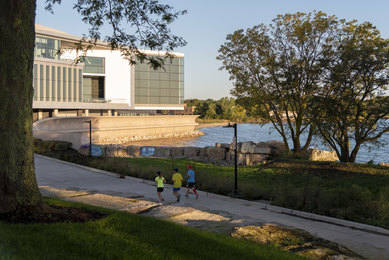Great Lake Cities: Blue-Green Infrastructure
While the Great Lakes have a long history cycling between high and low water levels, what we’re witnessing now is decidedly different. Over the past two years we have seen the highest water levels ever recorded on the Great Lakes. According to the U.S. Army Corps of Engineers, Lake Ontario reached its record high in September 2019. The remaining four Great Lakes and Lake St. Clair all reached monthly records for mean high-water levels in 2020.
These unprecedented high-water levels have had destructive impacts across the entire Great Lakes Basin, including extensive flooding, erosion, and damage to shoreline homes, buildings, infrastructure, harbors, and parks. A particularly severe storm in January led the City of Chicago and the State of Illinois to declare a local disaster and request emergency declarations from the Federal Emergency Management Agency (FEMA) for damages to nearly 30 miles of Lake Michigan shoreline.
Most experts agree that climate change impacts are exacerbating the Great Lakes’ water level cycle. It was only seven years ago that the lakes were coming off a decade of historic low water levels. Since 2013, a historic increase in regional precipitation has driven the lakes to their recent record highs. According to the National Oceanic and Atmospheric Administration’s National Centers for Environmental Information, the preceding 12-, 24-, 48- and 60-month periods leading up to December 2019 were the wettest recorded on the Great Lakes in over 120 years.
The immediate need for enhanced coastal protection is daunting, but the challenges extend beyond the Basin’s 14,000 miles of shoreline. In addition to driving up lake levels, the additional stormwater runoff has had an adverse impact on water quality. Enhanced infrastructure is also needed in upland areas to protect them from flooding while reducing polluting run-off.
This volume of Great Lakes Cities explores how the region’s challenging water level and water quality issues are being addressed through uniquely resilient approaches to blue/green infrastructure development and investment. With a focus on Lake Michigan, these stories and case studies highlight adaptive planning and design strategies that balance short and long-term protection for Great Lakes communities and the watershed. They also advance new approaches and partnerships for shoreline protection, ecological preservation, and community enhancement.
Chicago’s Harbors: A Case Study in Adaptive Decision-Making for Great Lakes Marinas
The City of Chicago has been grappling with the impacts of record-high water levels along its 28-mile lakefront, including damage and disruption to its extensive public harbor system. SmithGroup’s Mark Wagstaff explores the resiliency challenges they’ve been facing adapting to unprecedented operating conditions.
Northwestern University’s Wave Wall: A Design Retrofit for Coastal Resilience
By Margaret Boshek and Alejandra Lira-Pantoja
An innovative wave wall protects Northwestern University’s Ryan Fieldhouse & Walter Athletics Center from the waves and ice of Lake Michigan. Learn how SmithGroup’s coastal engineers helped develop this unique solution for coastal resilience.
Unpaving Paradise & Tearing Down Parking Lots: Milwaukee’s Gray-to-Green Infrastructure Movement
The City of Milwaukee & Milwaukee Public Schools have embarked on an impactful gray-to-green infrastructure movement that is converting underutilized parking lots and crumbling asphalt playgrounds into neighborhood-serving open space. These initiatives exemplify the broader role and impact that green infrastructure can have in neighborhood enhancement, reinvestment and equity.
Loyola University Chicago: A Tale of Two Resilient Campuses
By Bill Wood
SmithGroup’s work with Loyola University Chicago's main academic campus and its Loyola University Medical Center campus demonstrates the wider range of performance and benefits that can be realized when green infrastructure and stormwater management systems are conceived at a larger, more integrated scale.




